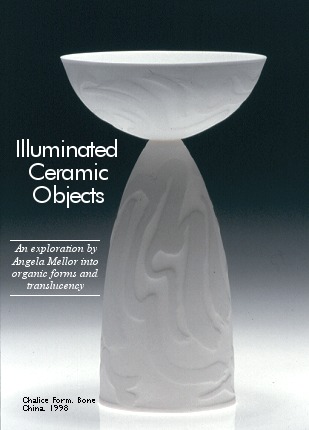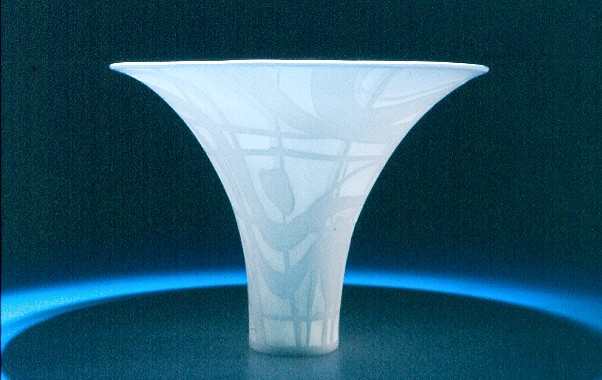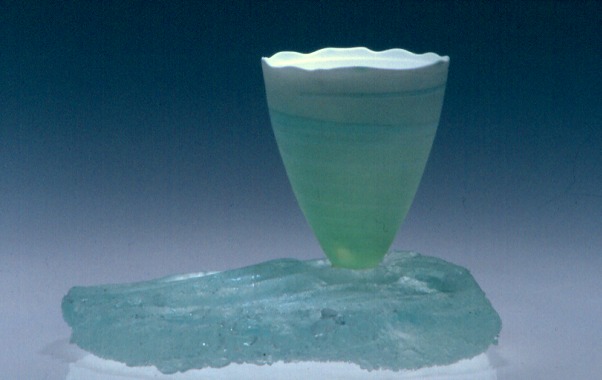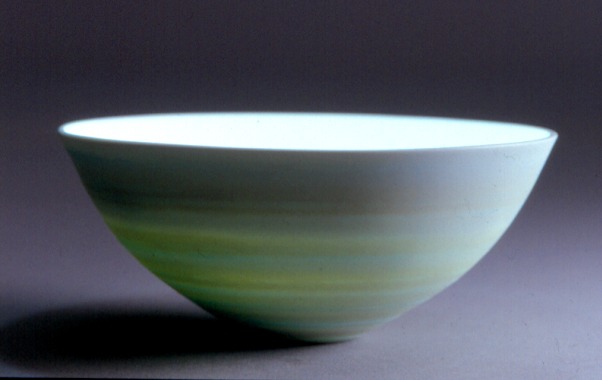“Illuminated Ceramic Objects,” Angela Mellor


Light Form. 1997. Bone China. 19 x 22 x 55 cm.

Bone China on Glass Ware. 1997. 9 x 13 cm.
THIS PROJECT INVESTIGATED THE TRANSLUCENCY OF BONE CHINA and its potential for the transmission of light. Through an exploration of plant and marine forms, where light plays an integral part in the structure, a body of work has been developed which accentuates the translucency and delicacy of these objects. My research began with an exploration of clay bodies.

Sea Bowl. Bone China with nitrates. 1997. Photo: Victor France.
At first, using commercially available porcelain, I tested for whiteness, translucency and warping in high temperatures. None of these clay bodies was to my satisfaction either in whiteness or in translucency. Therefore, I began to experiment with bone china recipes and ultimately developed one which met my expectations. I also experimented with mixing a paper pulp into the bone china casting slip to introduce texture. This process led to testing thickness and firing temperatures to achieve translucency. In addition to natural translucency I decided to explore artificial light through bone china. I took my design inspiration from the Datura flower or "Angels Trumpet'. I then made metal templates of this form which I used to turn on the plaster lathe in order to form the model. Subsequently, I made plaster moulds which enabled me to cast the forms thinly.
Photography has played a major part in my designs. My photographs of shadows of leaves and vines became the design which I later transferred on to the bone china and also a small teabowl designed specifically for this pattern. This pattern was created by the use of shellac painted on the fired piece and the background sponged back so the design appeared in relief. This process accentuated the varying depths of translucency. I learnt this method by studying works by Les Blakebrough and Arne Ase, the Norwegian potter, but using it in a different way, producing an all-over pattern with clear lines.
I also designed a small teabowl but found its round shape warped at high temperatures; this led me to make setters to control the warping. I felt that these small bowls could be presented in a box, Japanese in style, and I collaborated with a student from the furniture studio. Two boxes, one for two cups, and one for five cups were made, using black Japanese paper and cardboard; these open up for display purposes. The glass beads attached to the tie fastening ring like a bell when the box is opened.
I then felt the need to extend the range to vessel forms which could stand as a group, and I designed forms and made moulds. I found that these shapes could be joined together to create sculptural freestanding forms using the idea of wave bases for some of the pieces. Experiments in pate de verre glass in moulds made from the clay model produced a compatible material to be used in conjunction with bone china.
I made a photocopy of the photograph (usually of textures or patterns I have observed in nature). I then select an area and enlarge or reduce it to suit the object. Then I paint the design on the dry clay with shellac, freehand. When dry, the background is sponged back. The piece is allowed to dry and then the process is repeated again. Care must be taken not to wet the object too much or it may crack at the rim. A band of shellac on the rim will help prevent this from happening.
Bone China Recipe.
Cone 8-9.
(from O. S. Rye)
Eckalite No. 1 Kaolin 30
Bone ash natural 45
Potash feldspar 22.8
Silica 2.2
+ 2 gm dispex/kilo dry wt
+ 1 gm sodium silicate
600 ml water/kilo dry wt.









